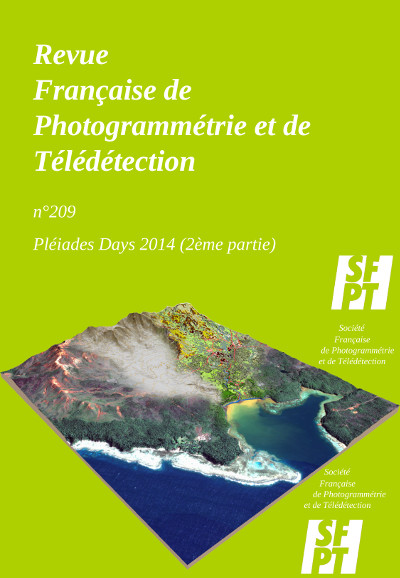Multi-scale methodology to map grey and green structures in urban areas using Pléiades images and existing geographic data
DOI:
https://doi.org/10.52638/rfpt.2015.237Keywords:
morphologie urbaine, imagerie Pléiades, Données urban structure, Pleiades imagery, ancillary data, object-based image classificationAbstract
Identification and monitoring of urban fabric and preservation of existing ecosystems have become major issues to maintain or increase biodiversity in areas under urban influence in most of European cities. While many studies have shown the interest of using optical remotely sensed data for that purpose, a consolidated and reproducible methodological framework was still missing. In this context, a multi-scale methodology has been proposed in the framework of the project VALI-URB to map built-up and vegetated land features in urban and suburban areas based on Pleiades images and existing ancillary data (vector databases or the Open Street Map database). The objective of this paper is to highlight the interest of using land cover/use maps derived from Pleiades images and vector databases to semi-automatically characterize grey and green infrastructures at a scale of 1:10,000. First results are presented on two medium-sized cities with different urban forms: Strasbourg and Rennes (France).
Downloads
References
Belgiu, M., DrÇŽguÅ£, L., 2014. Comparing supervised and unsupervised multiresolution segmentation approaches for extracting buildings from very high resolution imagery. ISPRS Journal of Photogrammetry and Remote Sensing 96, 67—75.
Breiman, L., 2001. Random Forests. Machine Learning 45, 5—32.
Burnett, C., Blaschke, T., 2003. A multi-scale segmentation/object relationship modelling methodology for landscape analysis. Ecological Modelling 168, 233—249.
Clinton, N., Holt, A., Scarborough, J., Yan, L., Gong, P., 2010. Accuracy Assessment Measures for Object-based Image Segmentation Goodness. Photogrammetric Engineering and Remote Sensing 76, 289—299.
Congalton, R.G., 1991. A review of assessing the accuracy of classifications of remotely sensed data. Remote Sensing of Environment 37, 35—46.
Cover, T., Hart, P., 1967. Nearest neighbor pattern classification. Information Theory, IEEE Transactions on Information Theory, 13, 21—27.
DrÇŽguÅ£, L., Tiede, D., Levick, S.R., 2010. ESP: a tool to estimate scale parameter for multiresolution image segmentation of remotely sensed data. International Journal of Geographical Information Science 24, 859—871.
He, H., Garcia, E.A., 2009. Learning from Imbalanced Data. IEEE Transactions on Knowledge and Data Engineering 21, 1263 —1284.
Heiple, S.; Sailor, D.J., 2008, Using building energy simulation and geospatial modeling techniques to determine high resolution building sector energy consumption profiles. Energy Build. 40, 1426—1436.
Herold, M., Hemphill J., Dietzel C., Clarke K.C, 2005, Remote sensing derived mapping to support urban growth theory, Proceedings of ISPRS, vol. XXXVI-8/W27., 6p.
Levine, M.D., Nazif, A.M., 1985. Dynamic Measurement of Computer Generated Image Segmentations. Pattern Analysis and Machine Intelligence, IEEE Transactions on PAMI-7, 155—164.
Loriot, P., 2008. Etude expérimentale : détermination d'un MOS et calcul d'une tache urbaine à partir de la BD TOPO® d'IGN.
Okada, S.; Takai, N., 2000, Classifications of Structural Types and Damage Patterns of Buildings for Earthquake Field Investigation. In Proceedings of the 12th World Conference on Earthquake Engineering, Auckland, New Zealand.
Puissant, A., 2003. Information géographique et images à très haute résolution : utilité et application en milieu urbain. Université Louis Pasteur - Strasbourg I.
Puissant, A., Hirsch, J., Weber, C., 2005. The utility of texture analysis to improve perâ€pixel classification for high to very high spatial resolution imagery. International Journal of Remote Sensing 26, 733—745.
Puissant, A., Rougier, S., Stumpf, A., 2014. Object-oriented mapping of urban trees using Random Forest classifiers. International Journal of Applied Earth Observation and Geoinformation 26, 235—245.
Vapnik, V.N., 1998. Statistical Learning Theory. Wiley-Blackwell, New York.
Vermote, E.F., Tanre, D., Deuze, J.L., Herman, M., Morcette, J.-J., 1997. Second Simulation of the Satellite Signal in the Solar Spectrum, 6S: an overview. IEEE Transactions on Geoscience and Remote Sensing, 35, 675—686.






